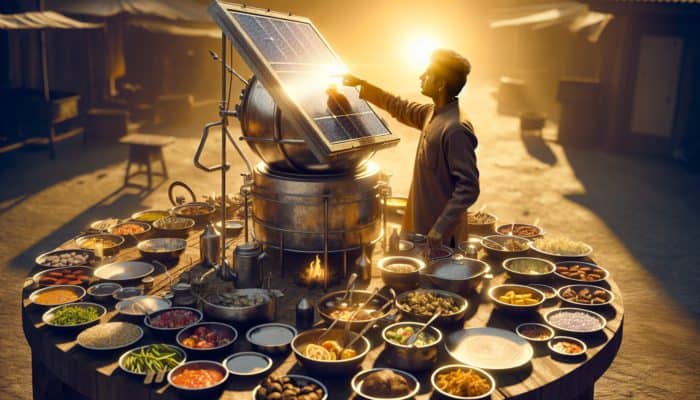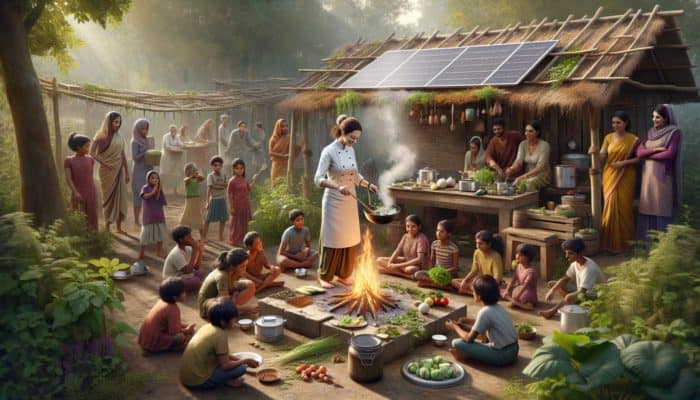Mastering the Art of Cooking Without Power
What Exactly Does Cooking Without Power Entail?

Cooking Without Power: Cooking without power is the fascinating practice of preparing meals using methods that do not rely on electricity or gas, embracing ancient techniques cherished by cultures worldwide for centuries. This form of cooking encourages both creativity and resourcefulness in the culinary arena, prompting individuals to discover innovative cooking methods that are not only practical but also sustainable. Common approaches to cooking without power include:
- Solar cooking
- open fire cooking
- Haybox cooking
- Pit cooking
- Thermal mass cooking
- Utilising a rocket stove
- Preserving food through fermentation and drying
By immersing oneself in these techniques, individuals deepen their connection with food while recognising the rich cultural heritage that these practices embody.
Discover the Advantages of Cooking Without Power
Embarking on the journey of cooking without power reveals a wealth of benefits that go far beyond mere meal preparation. Firstly, this approach champions sustainability by reducing dependency on fossil fuels and electricity, ultimately resulting in a smaller carbon footprint. Secondly, cooking without power is often more cost-effective, as it utilizes readily available resources rather than relying on expensive energy sources. Furthermore, this method cultivates a deeper connection with food, as individuals dedicate time and effort to crafting their meals. Here are some key advantages of cooking without power:
- Cost savings on energy bills
- Enhanced food security through self-sufficiency
- Environmental sustainability through reduced carbon emissions
- Improved health by prioritising fresh ingredients
- Strengthened community bonds through shared culinary experiences
- Encouragement of culinary creativity and experimentation
By embracing these practices, individuals can transform their cooking experiences into something that is both enriching and fulfilling.
Key Tools for Cooking Without Power
Having the right tools is essential for successfully mastering cooking without power. Various indispensable tools facilitate efficient meal preparation, enabling a smooth transition from conventional cooking methods. Solar cookers capture the sun's energy, while fire pits offer a classic outdoor cooking experience. Manual food processors and blenders empower users to prepare food without relying on electricity. Here’s a comprehensive list of essential tools for cooking without power:
- Solar cookers
- Fire pits or grills
- Rocket stoves
- Hayboxes or insulated cookers
- Portable charcoal grills
- Manual food processors
- Cast iron cookware
- Fermentation vessels
These tools empower cooks to explore a diverse range of culinary landscapes while adhering to sustainable practices.
Effective Techniques for Cooking Without Power

A variety of techniques are available for cooking without power, each presenting its unique set of benefits and applications across numerous environments and cuisines. Solar cooking harnesses the sun's energy—a renewable resource—to cook food. This method necessitates specific equipment designed to capture and retain heat effectively. Best practices for solar cooking include positioning the solar cooker towards the sun and using dark-coloured pots that enhance heat absorption.
Methods of open fire cooking, such as grilling or roasting, provide an authentic culinary experience often associated with gatherings and celebrations. Safety is paramount when cooking over an open fire, necessitating proper ventilation, careful firewood management, and having a water source on hand for emergencies.
Thermal mass cooking utilises retained heat to cook food slowly, employing materials such as bricks or stones to maintain warmth. To optimise the efficiency of this method, it is crucial to preheat the thermal mass before placing food inside, ensuring the best cooking conditions.
Prioritising Safety When Cooking Without Power
Ensuring safety while cooking without power is of utmost importance, as traditional cooking methods can pose unique challenges. Proper ventilation is crucial, especially when cooking over an open flame, to prevent the accumulation of harmful gases. Safe fire handling involves the use of appropriate tools and maintaining a safe distance from flammable materials. Adhering to food safety guidelines is essential for preventing spoilage and foodborne illnesses. Key safety considerations include:
- Maintaining appropriate food storage temperatures
- Using clean utensils and cookware
- Ensuring adequate ventilation when using open flames
- Practising good hygiene during food preparation
By following these safety measures, cooks can fully enjoy the benefits of cooking without power while minimising risks.
Insights from Experts on Cooking Without Power
What Insights Do Experts Offer on Cooking Without Power?

Experts in sustainable living and culinary arts advocate for cooking without power, highlighting its numerous advantages for both individuals and the environment. Many culinary professionals emphasize the significance of utilizing seasonal, locally sourced ingredients, which not only enhances flavor but also bolsters local economies. Real-world examples include chefs who conduct workshops to impart traditional cooking methods that forego modern conveniences. They champion techniques like open-fire cooking, demonstrating how to create flavourful dishes while decreasing reliance on electricity.
Moreover, sustainability advocates assert that cooking without power can lead to healthier eating habits. By steering clear of processed foods, individuals are more inclined to consume fresh, whole ingredients. Chefs encourage participation in community cooking events, where participants can share knowledge and skills, fostering a deeper appreciation for food and its origins.
How Can Cooking Without Power Enhance Your Health?
Cooking without power can significantly boost health by promoting the use of fresh, unprocessed ingredients. This transition often yields meals that are nutrient-dense and free from artificial additives. Practical steps for adopting healthier cooking methods without power include prioritising local and seasonal produce, which not only supports farmers but also guarantees the freshest ingredients. Embracing cooking techniques like fermentation, which preserves nutrients, and utilising methods such as solar cooking, can further elevate meal quality.
Additionally, cooking without power encourages mindfulness in the food preparation process. Engaging with food—such as chopping vegetables or stirring pots over an open flame—can become a meditative practice that enhances mental well-being. By focusing on the cooking process and being present in the moment, individuals can cultivate a healthier relationship with their food.
What Are the Environmental Effects of Cooking Without Power?
The environmental implications of cooking without power are significant, as this approach can considerably reduce carbon footprints and promote sustainable living practices. By opting out of conventional energy sources, individuals contribute to a reduction in greenhouse gas emissions. Expert evaluations indicate that methods such as solar cooking and open-fire cooking leverage renewable energy sources, minimising waste.
Additionally, cooking without power encourages the use of local ingredients, thereby reducing the environmental costs associated with transporting food over long distances. By adopting sustainable cooking practices, individuals not only improve their health but also actively contribute to protecting the planet for future generations.
In-Depth Techniques for Cooking Without Power
How to Effectively Use Solar Cooking?
Solar cooking capitalises on the sun's energy to prepare meals, establishing it as an eco-friendly and sustainable cooking alternative. To effectively utilise solar cooking, specific equipment—such as solar cookers or solar ovens—designed to concentrate sunlight is essential. Best practices for solar cooking include positioning the cooker to face the sun directly, adjusting the angle throughout the day, and using dark, heat-absorbent pots to maximise cooking efficiency.
Cooking times can fluctuate based on the intensity of sunlight, so patience is essential. Foods that are particularly well-suited for solar cookers include rice, beans, and vegetables, which can be prepared in a single pot to minimise energy loss. Additionally, experimenting with different recipes tailored for solar cooking can yield delightful results while promoting energy conservation.
Exploring Open Fire Cooking Techniques
Methods of open fire cooking, including grilling or roasting over a campfire, are timeless techniques that connect us to our ancestors. While incredibly rewarding, cooking over an open flame necessitates careful attention to safety. Essential safety precautions include selecting a designated fire pit area away from flammable materials and maintaining a nearby water source to extinguish the fire if necessary.
When preparing food, ensure that meats are cooked thoroughly to prevent foodborne illnesses, and use separate utensils for raw and cooked foods to avert cross-contamination. Exploring various cooking techniques—such as skewering vegetables or meats on sticks or using cast iron pots over coals—can lead to unforgettable culinary experiences under the open sky.
Utilising Thermal Mass for Effective Cooking
Thermal mass cooking is an innovative approach that employs retained heat for slow cooking, providing an efficient alternative to traditional cooking methods. This technique involves using materials like bricks, stones, or specially designed thermal cookers that retain heat for extended periods. To maximise the efficiency of thermal mass cooking, it is crucial to preheat the thermal mass before placing food inside—this ensures that the cooking process is both uniform and effective.
Foods that are particularly suited for this method typically include stews, soups, and grains, which benefit from the slow, even heat. Moreover, this technique encourages resourcefulness, as it often requires minimal fuel and can be executed in a variety of settings, from backyards to remote camping locations.
What Challenges Come with Cooking Without Power?
How to Effectively Overcome Time Constraints?
Cooking without power can occasionally present time constraints, particularly with methods like solar cooking that require extended cooking periods. However, effective planning and preparation can alleviate these challenges. One strategy involves utilising time-efficient cooking methods for quick meals, such as open-fire cooking or preparing dishes that can be left to cook slowly while engaging in other activities.
Batch cooking is another effective approach, allowing for the simultaneous preparation of multiple meals. By cooking larger quantities, individuals can save time during hectic weeks by simply reheating or enjoying leftovers. Additionally, employing techniques like haybox cooking—where food is placed in an insulated container after initial boiling—can significantly reduce cooking time while still resulting in delicious, fully cooked meals.
Adapting to Weather Dependencies
Weather conditions can significantly impact cooking methods without power, particularly solar cooking, which relies on sunlight. However, adapting cooking techniques to varying weather conditions is entirely feasible. For instance, on cloudy days, one can switch to open-fire cooking or thermal mass cooking, which are less dependent on ideal weather conditions.
In inclement weather, consider indoor cooking options that utilise thermal mass materials or insulated pots. Furthermore, planning meals around local weather forecasts can optimise cooking times and methods, ensuring that meals are prepared efficiently, regardless of external conditions.
Managing Limited Resources Effectively
Cooking without power often involves managing limited resources, such as fuel for open fire cooking or water for solar cooking. Developing effective resource management strategies is crucial. Prioritizing efficiency by using minimal fuel sources, such as small branches or twigs, for an open fire can help extend cooking capabilities.
Additionally, employing cooking methods that require fewer resources, like haybox cooking, can prove advantageous. This method utilises insulation to retain heat without necessitating continuous fuel. Lastly, preserving food through techniques like fermentation or drying can reduce the need for fresh ingredients, allowing cooks to optimise resources while minimising waste.
Ensuring Food Safety in the Absence of Power
Maintaining food safety while cooking without power is critical, as traditional refrigeration methods are often unavailable. Proper storage and cooking techniques are crucial for preventing spoilage and foodborne illnesses. First and foremost, ensure that all ingredients are fresh before use, particularly perishables like meats and dairy products.
Utilising cool storage methods, such as burying food in cool ground or using insulated containers, can help maintain safe temperatures. Cooking food thoroughly, particularly meats, is crucial for eliminating harmful bacteria. Finally, practising good hygiene during food preparation, such as washing hands and utensils, can significantly reduce the risk of contamination.
Research-Backed Advantages of Cooking Without Power
What Do Studies Reveal About Nutritional Benefits?
Research indicates that cooking without power can preserve more nutrients in food compared to traditional cooking methods that rely on electricity or gas. Studies demonstrate that techniques such as solar cooking and steaming help retain vitamins and minerals that can be lost through conventional cooking methods, such as boiling at high temperatures.
Moreover, cooking without power often emphasises the use of whole, unprocessed ingredients, contributing to a higher nutritional quality in meals. The focus on fresh produce promotes a diet rich in essential nutrients, resulting in improved overall health. Consequently, individuals who adopt these cooking methods are likely to experience significant improvements in their dietary habits and overall health outcomes.
How Does Cooking Without Power Affect Mental Health?
Cooking without power has the potential to positively influence mental health by promoting mindfulness and reducing reliance on technology. Engaging in the tactile experience of preparing meals—chopping, mixing, and cooking—can serve as a form of meditation, allowing individuals to disconnect from the digital world and reconnect with their senses.
Actionable steps for enhancing mental well-being through cooking without power include establishing a routine that incorporates cooking as a form of self-care. This could involve setting aside time each week to experiment with new recipes, inviting friends or family to share in the cooking experience, or even taking classes to learn traditional cooking techniques. Such activities foster a sense of community and connection, further enhancing mental health.
Environmental Sustainability through Cooking Without Power
Cooking without power significantly contributes to environmental sustainability by decreasing greenhouse gas emissions associated with traditional cooking methods. By employing renewable energy sources, such as solar or biomass, individuals can help lessen reliance on fossil fuels. Expert evaluations indicate that implementing these practices not only reduces carbon footprints but also encourages a sustainable lifestyle.
Additionally, cooking without power frequently promotes a lifestyle centered around local and seasonal ingredients, minimizing the environmental costs associated with transporting food. This holistic approach to cooking enhances appreciation for the environment, as individuals become more aware of their food sources and the impact their choices have on the planet.
How Can Cooking Without Power Foster Social Connections?
Cooking without power can significantly strengthen social connections by encouraging communal cooking and sharing meals. Traditional cooking methods often bring families and communities together, fostering collaboration and a sense of bonding over shared culinary experiences.
One effective way to reinforce community ties is by organising potlucks or community cooking events, where individuals can exchange recipes and cooking techniques while enjoying each other’s company. Moreover, teaching friends or family members how to cook without power creates opportunities for shared experiences and learning, deepening relationships through the joy of food preparation.
Integrating Cooking Without Power into Your Everyday Life
How to Seamlessly Incorporate Cooking Without Power Into Your Routine
Integrating cooking without power into daily life necessitates planning and adaptability. Start by introducing small changes into your routine, such as dedicating one day a week to exploring solar cooking or open-fire techniques. Gradually expanding this practice allows for a smoother transition, transforming it into a more enjoyable experience.
Additionally, consider meal prepping for the week using cooking methods that don't require power. For instance, utilise haybox cooking for slow-cooked meals or prepare larger batches of food that can be reheated. Over time, these practices will become second nature, making cooking without power an integral component of your culinary lifestyle.
How to Teach Children the Joy of Cooking Without Power
Teaching children to cook without power can instill invaluable life skills while promoting sustainability. This educational experience can be enjoyable and engaging by making learning fun through hands-on activities and interactive cooking sessions.
Consider organizing family cooking nights where children can assist in meal preparation using traditional methods, such as open-fire cooking or solar cooking. Encourage creativity by allowing them to select ingredients and experiment with recipes, fostering a sense of ownership over their culinary creations. This approach not only builds essential skills but also deepens their appreciation for food and its origins.
Finding Harmony Between Modern and Traditional Cooking Methods
Finding a balance between modern and traditional cooking methods allows for flexibility and variety in meal preparation. Combining these approaches can optimise efficiency while still honouring culinary traditions. For example, a modern slow cooker can be used in conjunction with traditional methods, such as solar cooking, to create a diverse range of meal options.
The benefits of this balance include the chance to experiment with new techniques while still enjoying the comfort and familiarity of modern conveniences. This blend can lead to innovative recipes that reflect both contemporary and traditional influences, celebrating the best of both culinary worlds.
How to Overcome Challenges and Limitations of Cooking Without Power
Addressing common challenges, such as time constraints and weather conditions, is essential for making cooking without power more feasible and enjoyable. Effective planning and preparation can mitigate these challenges. For example, utilising quicker cooking methods, like open-fire cooking, can save time when preparing meals.
Moreover, having backup plans for adverse weather conditions—such as maintaining alternative cooking methods—can ensure that meals are consistently prepared without power. Additionally, embracing resourcefulness and creativity in the kitchen can transform limitations into opportunities for culinary innovation, enriching the cooking experience.
Emerging Trends in Cooking Without Power
Innovations in Cooking Without Power Technology
Innovations in cooking without power technology are constantly evolving, introducing new and efficient ways to prepare meals. Recent advancements include solar cookers designed for improved efficiency, such as parabolic solar cookers that concentrate sunlight more effectively, enabling faster cooking times.
Other innovations involve the development of portable biomass stoves that can utilise waste materials, reducing environmental impact while providing cooking solutions in off-grid settings. As technology progresses, these new tools will further enhance the practicality of cooking without power, making it accessible to a broader audience.
The Importance of Cooking Without Power in Sustainable Living
Cooking without power plays a crucial role in sustainable living, promoting eco-friendly practices that diminish reliance on non-renewable energy sources. By embracing these methods, individuals contribute to a more sustainable lifestyle that minimises waste and prioritises local food sources.
Moreover, cooking without power fosters mindfulness in consumption, cultivating an awareness of resource usage and the origins of food. This lifestyle choice benefits individuals and has a broader impact on the community and environment, contributing to a more sustainable future.
Cultural and Community Aspects of Cooking Without Power
Cooking without power nurtures community and cultural connections, often rooted in traditional methods and shared experiences. Celebrating these culinary practices helps preserve cultural heritage while advocating for sustainable living.
Community events focused on cooking without power can bring individuals together, allowing them to share their stories, recipes, and techniques. This shared experience not only strengthens community bonds but also preserves cultural traditions, enriching the culinary landscape for generations to come.
Frequently Asked Questions
What Are the Most Effective Methods for Cooking Without Power?
The most effective methods for cooking without power encompass solar cooking, open fire cooking, haybox cooking, and utilising thermal mass techniques. Each method presents unique advantages, such as sustainability and efficiency.
How Can I Start Cooking Without Power?
Begin by incorporating small adjustments into your cooking routine, such as using a solar cooker on sunny days or trying open fire cooking during camping trips. Gradually build your skills and confidence over time.
What Tools Are Necessary for Cooking Without Power?
Essential tools for cooking without power include solar cookers, fire pits, rocket stoves, insulated hayboxes, and manual food processors. These tools facilitate various cooking techniques efficiently.
Is Cooking Without Power Safe for Food Preparation?
Yes, cooking without power can be safe if proper food safety practices are followed, such as thorough cooking, maintaining hygiene, and ensuring proper food storage to prevent spoilage.
Can Cooking Without Power Lead to Financial Savings?
Absolutely! Cooking without power can yield significant savings on energy bills, as it reduces dependence on electricity and gas. Moreover, sourcing local ingredients can lower grocery expenses.
How Does Cooking Without Power Benefit the Environment?
Cooking without power helps reduce carbon footprints by utilizing renewable energy sources and minimizing waste. It promotes sustainable practices that benefit the planet.
What Health Benefits Are Associated with Cooking Without Power?
Cooking without power often results in healthier meals, as it highlights fresh ingredients and avoids processed foods. This can lead to enhanced nutrition and overall health.
Can Children Learn to Cook Without Power?
Yes! Teaching children to cook without power can impart valuable skills and foster sustainability. It can be a fun and educational experience that nurtures creativity in the kitchen.
How Can I Maximise Efficiency When Cooking Without Power?
To maximise efficiency, plan your meals, utilise batch cooking, and experiment with time-saving techniques like haybox cooking or thermal mass cooking to minimise fuel use.
What Challenges Are Associated with Cooking Without Power?
Challenges include time constraints, weather dependencies, limited resources, and ensuring food safety. However, effective planning and adaptability can help overcome these hurdles.
Discover more on our journey at X!
Freeze-Dried Food Reviews: A Comprehensive Guide
Comprehensive Guide to Understanding Freeze-Dried Foods What Exactly Are Freeze-Dried Foods? Freeze-Dried Food Reviews: Freeze-dried foods represent an impressive culinary innovation aimed at maintaining the natural characteristics of fresh produce while significantly prolonging their shelf life. The freeze-drying process involves removing moisture from food, a technique that effectively preserves both nutritional value and flavor. This method […]
Food Preservation Tools: Essential Techniques and Equipment
Essential Tools for Preserving Food Effectively What Are the Key Tools for Food Preservation? Food Preservation Tools: Food preservation tools encompass a variety of essential devices and methods designed to extend the shelf life of food while ensuring its quality and safety. These tools range from basic kitchen implements to sophisticated technological systems. Whether you […]
Edible Insects Guide: A Comprehensive Overview
Understanding the World of Edible Insects What Exactly Are Edible Insects? Edible Insects Guide: Edible insects refer to various species of insects that are deemed safe for human consumption. These insects are an integral part of traditional diets in numerous cultures worldwide, providing a sustainable and rich source of protein. The growing acceptance of insects as […]
Cooking Without Utensils: A Universal Guide
Explore the Art of Cooking Without Traditional Utensils What Does Cooking Without Utensils Entail? Cooking Without Utensils: Cooking without utensils is a fascinating culinary practice that involves preparing meals while utilising minimal or no conventional kitchen tools. This innovative approach encourages chefs to rely on natural resources and creative techniques, fostering a deeper connection with […]








The idea of cooking without power really resonates with me! Recently, I tried solar cooking for the first time, and it was such a rewarding experience. Watching the sun transform the ingredients over several hours brought a new level of mindfulness to the process. It made me appreciate the food in a way that the convenience of electric cooking sometimes overshadows.
The concept of cooking without power truly resonates with my own culinary journey, as I’ve been exploring sustainable living practices for the past few years. There’s something incredibly grounding about reconnecting with traditional cooking methods that not only require us to think creatively but also encourage a profound appreciation for the food we prepare and consume.